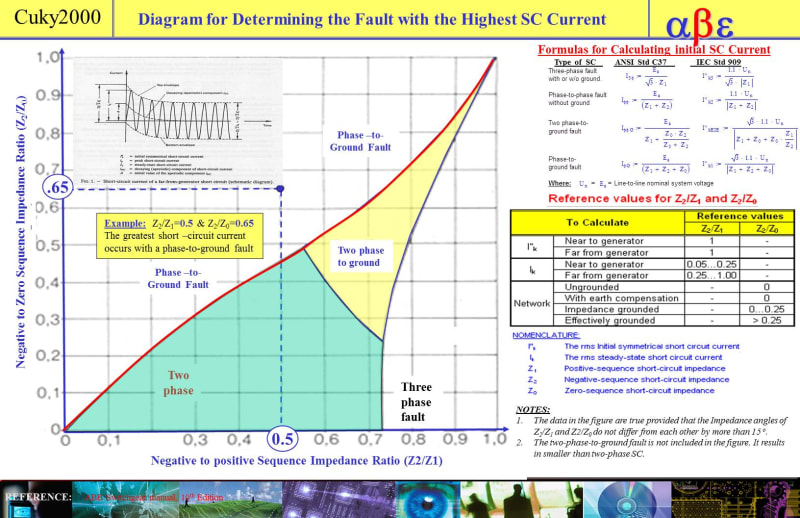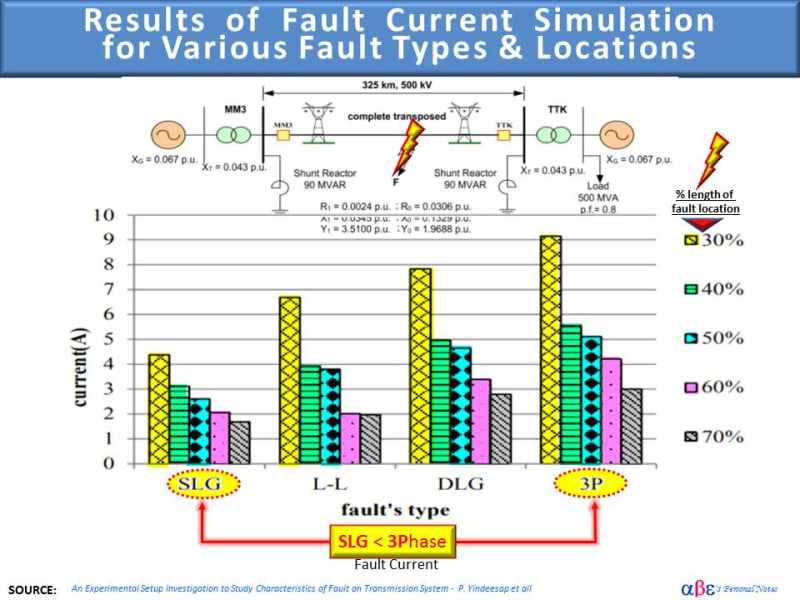Navigation
Install the app
How to install the app on iOS
Follow along with the video below to see how to install our site as a web app on your home screen.
Note: This feature may not be available in some browsers.
More options
Style variation
-
Congratulations TugboatEng on being selected by the Eng-Tips community for having the most helpful posts in the forums last week. Way to Go!
You are using an out of date browser. It may not display this or other websites correctly.
You should upgrade or use an alternative browser.
You should upgrade or use an alternative browser.
What is the single line to ground UTILITY fault current and X/R when only given the 3-phase info? 1
- Thread starter bdn2004
- Start date
- Status
- Not open for further replies.
There is not a universal rule of thumb to determine the SC of SLG/LLL. All depends on multiple factors such as the location of the fault, transformer connections, system configuration, etc. However, If the sequence impedances data is available, the worst short circuit LLL, SLG or LL fault could be estimated by the curve below. Should be noted that 3 phase fault it is the usual the largest value.
Regarding the utility X/R ratio, this is usually high on a typical range to assume from 10 t0 20

Regarding the utility X/R ratio, this is usually high on a typical range to assume from 10 t0 20

You can't assume this for a variety of reasons. A lot of sources that contribute to a phase fault may not have a zero sequence path to contribute for a ground fault. There are 'rules of thumb,' but for an HV system you need to get the actual ground fault values if settings any ground/neutral elements.
- Thread starter
- #4
I'm only talking about the short circuit data received from the Utility, not analyzing a fault on the system. The sequence impedances are not given either. They've given us the 3-phase fault current, and an X/R ratio. But our program requires the SLG numbers too. Is it reasonable to make them the same ?
Looking at the graph....Is the outer edge curved line forming the boundary of the area of the greatest 3-phase fault? Say Z2/Z1 = 0.9 not 0.5 as shown, and Z2/Z0 = 0.65 as shown...then the 3-phase fault is the highest number?
Looking at the graph....Is the outer edge curved line forming the boundary of the area of the greatest 3-phase fault? Say Z2/Z1 = 0.9 not 0.5 as shown, and Z2/Z0 = 0.65 as shown...then the 3-phase fault is the highest number?
bdn2004, the values from the utility will have to take into account the system. You can't accurately guess the ground fault values based on three phase values. It should be fairly simple for the utility to provide this information - i'd suggest just asking for it.
- Thread starter
- #7
HamburgerHelper
Electrical
You can use rules of thumb for the zero sequence impedance of transmission lines but I wouldn't make an assumption of the thevinen impedance for a fault. I believe at most the fault current can be 50% greater than a three phase fault. You should get the information from them but I think this could give you a ballpark range of what the most it could be.
3PhaseFault = V/Z1
SLGfault = 3*V/(Z1+Z2+Z0) = assuming Z2 = Z1 and Z0 = 0 = 1.5*V/Z1
------------------------------------------------------------------------------------------
If you can't explain it to a six year old, you don't understand it yourself.
3PhaseFault = V/Z1
SLGfault = 3*V/(Z1+Z2+Z0) = assuming Z2 = Z1 and Z0 = 0 = 1.5*V/Z1
------------------------------------------------------------------------------------------
If you can't explain it to a six year old, you don't understand it yourself.
Hi HamburgerHelper,
Please help us to reconcile the disagreement witch fault is the most severe between SLG and 3Phase fault.
>>>>>>>>>>>>>>> [highlight #FCE94F](3PhaseFault = V/Z1) < ? (SLGfault = = 1.5*V/Z1)[/highlight] <<<<<<<<<<<
Below are an illustration and a couple of links indicating that the most severe fault is the 3 phase fault for most cases. However, there are cases where the SLG fault is larger than the 3Phase fault.

1)
2)
Please help us to reconcile the disagreement witch fault is the most severe between SLG and 3Phase fault.
>>>>>>>>>>>>>>> [highlight #FCE94F](3PhaseFault = V/Z1) < ? (SLGfault = = 1.5*V/Z1)[/highlight] <<<<<<<<<<<
Below are an illustration and a couple of links indicating that the most severe fault is the 3 phase fault for most cases. However, there are cases where the SLG fault is larger than the 3Phase fault.

1)
2)
-
1
- #10
davidbeach
Electrical
Close to solidly grounded delta-wye transformers the magnitude of a SLG fault will be greater than the magnitude of a 3LG fault. Z0 won’t actually be zero but it will be noticeably lower than Z1 or Z2. Moving away from the transformer Z0 increases much quicker than Z1 and Z2. Once Z1 + Z2 + Z0 exceeds 3*Z1 the magnitude of a 3LG fault will exceed the magnitude of a SLG fault.
HamburgerHelper
Electrical
Cuky,
That is assuming Z1=Z2 ,which is true or near true since only rotating machines have different positive and negative impedances, and I am assuming Z0=0, which is assuming you are right up against the wye side of a delta wye transformer.
Assume Z2 = Z1 and Z0=0
SLG = 3*V/(Z2+Z2+Z3) = 3*V/(Z1+Z1+0) = 3*V/(2*Z1) = 1.5*V/Z1 = 1.5*(Three_Phase_Fault)
------------------------------------------------------------------------------------------
If you can't explain it to a six year old, you don't understand it yourself.
That is assuming Z1=Z2 ,which is true or near true since only rotating machines have different positive and negative impedances, and I am assuming Z0=0, which is assuming you are right up against the wye side of a delta wye transformer.
Assume Z2 = Z1 and Z0=0
SLG = 3*V/(Z2+Z2+Z3) = 3*V/(Z1+Z1+0) = 3*V/(2*Z1) = 1.5*V/Z1 = 1.5*(Three_Phase_Fault)
------------------------------------------------------------------------------------------
If you can't explain it to a six year old, you don't understand it yourself.
HamburgerH: Thanks for your fast response. I will guess that we may be in agreement that SLG varies possible in a range 0< ISLG < 1.5I3∅ depending upon the system grounded (Zero sequences and the impedance of the ground return path of the fault current.
Bdn2004:
Here is a suggestion to run a few cases in the SC program:
1) ISLG = I3∅ Fault
2) Couple cases: ISLG ≤ 1.5x I3∅ Fault
3) Couple cases: with: ISLG ≥ 1/1.5x I3∅ Fault
If there is a Delta-Wye power transformer connected to the utility, there is a possibility that the changes in the SC level may not be dramatically different. Otherwise, get the actual values from the utility.
Please let us know.
Bdn2004:
Here is a suggestion to run a few cases in the SC program:
1) ISLG = I3∅ Fault
2) Couple cases: ISLG ≤ 1.5x I3∅ Fault
3) Couple cases: with: ISLG ≥ 1/1.5x I3∅ Fault
If there is a Delta-Wye power transformer connected to the utility, there is a possibility that the changes in the SC level may not be dramatically different. Otherwise, get the actual values from the utility.
Please let us know.
If you are using a standard form for asking for three phase fault current and X/R, maybe you should revise the form to include ground fault current.
I know that many times I just get a long form asking for everything anyone would ever want. So I just call the customer and ask what exactly do they want.
Be specific on what you want, without asking for too much, as a way to respect the utility engineers time. (Keep It Simple).
For some reason I seem to get requests like this only on the worst day and time.
I know that many times I just get a long form asking for everything anyone would ever want. So I just call the customer and ask what exactly do they want.
Be specific on what you want, without asking for too much, as a way to respect the utility engineers time. (Keep It Simple).
For some reason I seem to get requests like this only on the worst day and time.
- Status
- Not open for further replies.
Similar threads
- Question
- Replies
- 3
- Views
- 10K
- Question
- Replies
- 9
- Views
- 19K
- Locked
- Question
- Replies
- 7
- Views
- 7K
- Locked
- Question
- Replies
- 7
- Views
- 5K
- Locked
- Question
- Replies
- 6
- Views
- 5K
